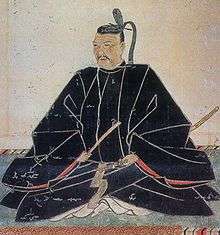Asano Nagamasa
Asano Nagamasa (浅野 長政, 1546 – May 29, 1611) was the brother-in-law of Toyotomi Hideyoshi and one of his chief advisors. Asano also fought for Oda Nobunaga and Hideyoshi in a number of campaigns during the Sengoku period of the 16th century of Japan.

Since O-Ne (whose real father was Sugihara Sadatoshi, a descendant of Taira no Sadamori, and was adopted by her uncle Asano Nagakatsu, a descendant of Minamoto no Yorimitsu (944-1021)), married Kinoshita Tokichiro (later Toyotomi Hideyoshi), despite her mother Asahidono opposition to this marriage because of the difference in social status with her husband, Nagamasa became a brother-in-law to Hideyoshi.
In 1581, he fought in the Second Tenshō Iga War under Oda Nobunaga against inhabitants of Iga, at Iga province.
In 1583, he distinguished himself in the Battle of Shizugatake and was given 20,000 koku in Otsu (Omi Province). He accompanied Hideyoshi in his campaign against the Mōri clan.
In 1587, he served in the campaign to suppress Kyushu and received Obama Domain (80,000 koku) (Wakasa province). He also fought for Hideyoshi against the Hōjō clan in 1590 Siege of Odawara, captured Iwatsuki and Edo castles.
In 1591, he fought against the Kunohe Rebellion. In 1593, made a great contribution to the dispatch of troops and was given 215,000 koku of Fuchu (Kai province).
Asano was also appointed by Hideyoshi to a Commission of Five (Go-Bugyō) along with Ishida Mitsunari, Maeda Gen'i, Mashita Nagamori and Natsuka Masaie. Asano held seniority over the Commissioners, who were charged with governing the capital of Kyoto and the Home Provinces or Kinai. A close advisor to Hideyoshi, Asano devised the land survey and a number of other policies enacted under his rule.
In 1598, Hideyoshi's invasions were coming to an end, and Asano was sent to Korea with his fellow Commissioner Ishida Mitsunari to arrange for Japanese withdrawal. Asano was assured by the generals that the war was going well, and that they were on the verge of victory. Ishida disagreed, however, and supported withdrawal from Korea. Returning to Japan, daimyō (feudal lords) from across the country became involved in the debate, and the disagreement grew into a major governmental rift. The Go-Bugyō disbanded soon afterwards, having already been replaced by the Council of Five Elders (Tairō) by Hideyoshi before his death.
In 1599, he transferred the family estate to his son Asano Yoshinaga and retired.
In 1606, he was given Makabe, in Hitachi Province (50,000 koku) as retirement stipend.
Family
- Father: Yasui Shigetsugu, lord of Miyago castle, and descendant of Hatakeyama Iekuni, Shugo of Kawachi province
- Mother: Asano Nagaaki's Daughter
- Foster Father: Asano Nagakatsu (d.1575), lord of Yasui castle, then lord of Asano castle, a descendant of the Toki clan and of Minamoto no Yorimitsu (944-1021)
- Foster Mother: Nanamagari-dono (d.1603)
- Wife: Cho-Sei-in (d.1616), daughter of Asano Nagakatsu
- Children:
- Asano Yoshinaga by Cho-Sei-in
- Asano Nagaakira by Cho-Sei-in
- Asano Nagashige (1588-1632) by Cho-Sei-in
- daughter married Sugihara Nagafusa
- daughter married Hori Chikayoshi
- daughter married Matsudaira Sadatsuna
- daughter married Sadao Mitsusada
References
- Sansom, George (1961). "A History of Japan: 1334-1615." Stanford: Stanford University Press.
- Turnbull, Stephen (1998). 'The Samurai Sourcebook'. London: Cassell & Co.